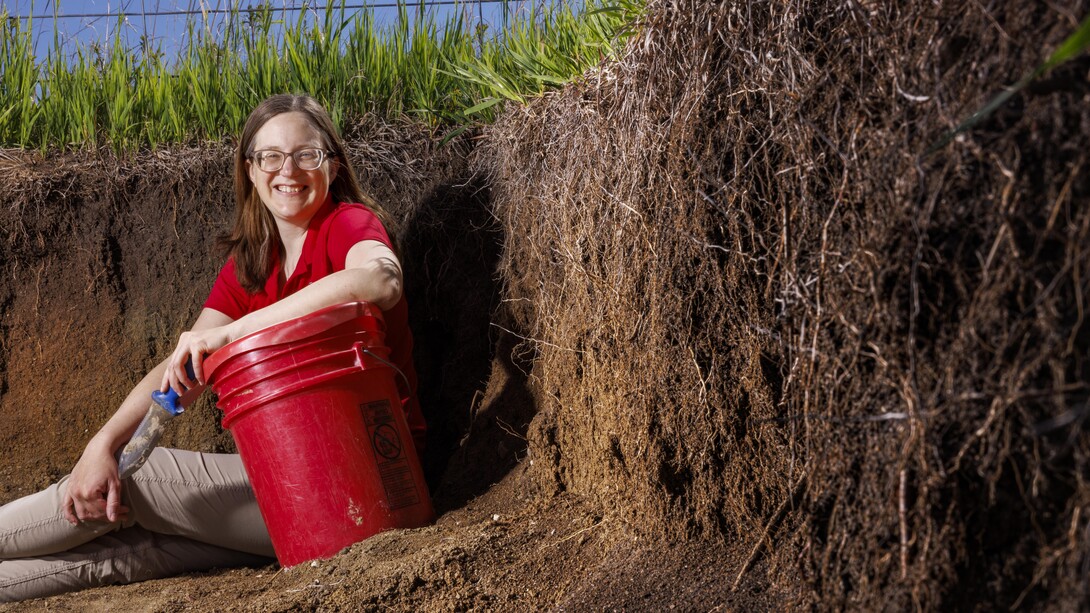
Nebraska’s Judith Turk will use an $845,000 grant from the National Science Foundation’s Faculty Early Career Development Program to dig into the degradation of topsoil.
Agricultural productivity across the Great Plains is tied directly to the soil that covers it. Known to soil scientists as Mollisols, these thick, dark, organic-rich soils are inherently productive and fertile, helping farmers cultivate high-yielding crops.
But the very traits that make these soils conducive to agriculture are problematic for researchers trying to track the change in soil quality over time — which has important implications for food security and resilience to climate change.
“The thick topsoil in the Great Plains masks the effect of gradual degradation until it reaches an advanced stage,” said Turk, an associate professor and soil scientist at the University of Nebraska–Lincoln. “Degradation processes are slow, but they are happening.”
In her five-year soil study, which will integrate research, education and outreach, Turk will compare legacy soil data to today’s soil data to quantify change across various characteristics. She also will launch a new course at the university, introduce new teaching strategies and develop an outreach program for middle school students.
Pinpointing the degree and pace of soil change — and how deeply into the soil that change extends — is critical for developing effective strategies to mitigate and adapt to climate change. Turk’s research will inform soil carbon sequestration strategies and advance understanding of soil health, which is key to agricultural systems’ capacity to withstand extreme weather.
“The healthier our soils are, the more resilient our ecosystems and agricultural systems are,” Turk said.
To assess soil change, Turk is using data collected between 1968 and 1994 as a reference point. She will compare that information to data collected using modern methods of soil structure analysis, enabling her to gauge how Great Plains soils are changing over the course of decades. Turk will investigate standard soil characterization data, including physical and chemical properties of the soil, and conduct computed tomography analysis of pore networks in the soil.
Together, these characteristics help scientists understand how air, water, nutrients and energy are moving through the soil. These dynamics are critical to understanding how the pedosphere — the uppermost layer of the Earth’s surface — functions as part of the global carbon cycle.
Turk’s approach represents a new way of looking at the study of soils. Her research is reshaping the traditional definition of pedology as the study of soil’s natural bodies.
“This idea of thinking of soil as a body that’s undergoing continual rapid change over decadal time scales is a different approach to pedology,” she said. “This will help us to transform our view of the information that’s conveyed through static soil maps.”
Turk expects her findings to establish that the trajectory of soil change is closely linked to the way land is used. Clarifying this relationship will illuminate the degree to which today’s soil maps — important decision-making tools for farmers, builders and beyond — are accurately classifying soils and capturing change. She is particularly interested in exploring the long-term impacts of irrigation: Her preliminary data indicate irrigation may increase soils’ carbon storage capacity.
Turk also aims to advance knowledge about a much-debated topic in the soil science field: the erosion-induced carbon sink. This idea — that carbon released via agricultural erosion is absorbed into depositional soil, where it can accumulate in a stable fashion — challenges the conventional view that agricultural erosion is a significant source of atmospheric carbon. In some areas, erosion may lead to higher levels of carbon storage in the soil.
“This is an aspect of the carbon cycle that we need to understand better,” Turk said. “The strategy of looking at soil data from a long time ago and soil data from today will help to shed more light on it.”
Turk’s research is innovative for exploring human-driven soil change below the surface. So far, most research in this area has focused on the top layers, because they are in closest contact with people. Turk predicts human impacts extend much deeper, likely affecting water flow through the subsoils — a major factor in soil health and carbon storage ability.
Turk will launch a first-of-its-kind course at Nebraska that pairs soil science field methods with the stories of people on the land where she is conducting research. Through this course, Turk hopes to deepen students’ affective learning, which refers to acquiring knowledge via emotional engagement.
She will also engage middle school students by infusing soil science with art and technology. Partnering with the Lincoln Community Learning Centers, which provide academic programming in underserved areas, Turk and her students will offer after-school sessions and summer camps focused on connections between the soils, soil color, the carbon cycle and climate change. Activities will include soil painting and using color sensors to measure soil color.
The National Science Foundation’s CAREER award supports pre-tenure faculty who exemplify the role of teacher-scholars through outstanding research, excellent education and the integration of education and research.








